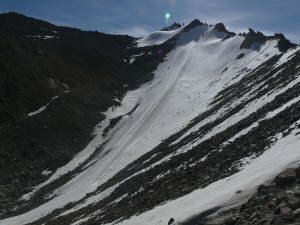18,380 feet above sea level, at the Khardung-La pass, I finally feel a measure of what they call altitude sickness. I've been in Ladakh a week, felt nothing, but here I am slightly dizzy with each step I climb to reach an observation post above the road. Take it slow, I remind myself, take it one step at a time. But that, in its entirety, is my brush with the sickness friends told me to watch out for in Ladakh.
Yet as I stand here, I feel sick in a way that has zip to do with altitude.
At my feet is a shallow valley. On the slope that rises from it, across from where I stand, a spectacular stretch of ice gleams in the early morning sunlight. Combine that with the distant vista of the snow-topped Karakoram range, the khaki-shaded expanses of the lesser hills, and my light-headedness: this is in every sense a breathtaking spot. My task is this: I'm trying to understand why the Sarikas and Vijays and Jayants who have been here before me have reacted to this beauty by flinging their garbage into the valley.
Yes: if the slope that rises out of the valley is that gorgeous sheet of white ice, the slope that descends into the valley is a miasma of trash. Milk containers, packets of chips, water bottles, and I'm sure that brown cuboid halfway down is filled with sliced bread. Really, why would people come all the way to this fabulous spot, then blight it like this?

|

|
| Why would people come all the way to this fabulous spot, then blight it like this? | |
I went to Ladakh two weeks after the flash flood calamity of early August. For me, the strange thing was that it wasn't just mourning for the injured and dead, or worries about longer-term rehabilitation efforts, that I encountered there. There was all that, sure. But the disaster also seems to have got locals talking about other issues, wondering aloud about what is happening to their Ladakh, and in a sort of collective bout of introspection, whether this flood is some kind of warning. Maybe even payback.
One of those issues is the kind of tourism that they see in Ladakh these days. Here's the story as described to me by tour agents and restaurateurs, fruit vendors and two old men above a boulder-strewn river and a man who runs an internet cafe: in bits here, pieces there, whole somewhere else - all to the point that I began to wonder if this was a watershed moment for Ladakh (no pun meant).
Traditionally - I heard - Ladakh has attracted mostly a certain kind of tourist: hardy backpacking trekkers who arrive in Leh, take a couple of days to acclimatise to the altitude, then set off on hikes through Ladakh's spectacular wilderness, often stopping at some of the ancient monasteries that dot the landscape. Ten days later, they return to Leh, wind down for another day or two, and leave. Such people were usually foreigners. Respectful and appreciative of the wonders they see, they would go home and spread the word to friends about Ladakh's pristine charms. This way, Ladakh had a steady flow of tourists coming through. Enough to give most folks here a reasonable income, but not enough for Ladakh to suffer the ravages of mass tourism.
Something has changed - I heard again - in the last couple of decades. There has been an growing number of tourists who expect only to be driven from one sight to another in quick succession - "jeep safaris", these jaunts are called. There are even week-long package tours now available, at attractive flights-included prices. The greatest part of the week is spent driving, on some days hundreds of kilometres.
Throngs of such tourists arrive in Ladakh every week. The majority is Indian.
Undeniably, this is excellent business for a lot of Ladakhis. But the flash flood has got some of them thinking. The rush of money and rising aspirations ("our greed", several called it sadly) has driven people to build indiscriminately, often ignoring earlier generations' knowledge about staying away from where water was known to flow. The tragedy is that exactly those kinds of built-up areas were wrecked on the night of 5 August.
But this kind of tourism has also meant a steep increase in the number of vehicles: Leh's market is so overrun with cars, it could be a snapshot of Dadar, or South Extension Part II. It's brought pollution even I could sense, fumes you breathe in as you stroll almost anywhere in town, tangible in the otherwise crisp air.
And it's brought garbage. Not that you can blame just outsiders for the occasional piles of trash you see lying around in Leh. But Ladakh's new breed of mostly-Indian tourists are clearly the trash-flinging sorts we all are in all our cities, and why would we leave that aptitude behind on package tours? That must account for the nauseating vista on the slope at Khardung-La. Nobody lives up there, after all.
I travelled to Ladakh expecting two things: scenes of devastation and altitude sickness. The irony is that I found both in, of all places, Khardung-La. Leptospirosis can't be far behind.
























